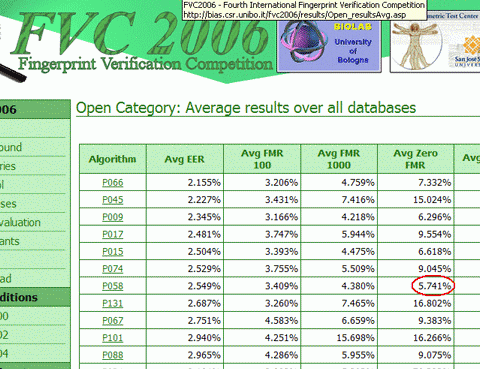FVC2006, FVC2004, FVC2002 and FVC2000 results
Neurotechnology participated in the Fingerprint Verification Competition several times under the name Neurotechnologija. The participations resulted in numerous medals for reliability and performance.
FVC2006 results
Neurotechnology's results in the Fingerprint Verification Competition (FVC2006) achieved the highest ranking when using the most realistic benchmark for real-world biometric applications, "Average Zero FMR."

FVC2006 Open Category results.
The whole page is available at the FVC2006 web site.
Neurotechnology algorithm is denoted there as P058.
Neurotechnology also won four gold medals, two silver and two bronze medals in the FVC2006 Open Category.
Our algorithm took second place in the FVC2006 Light Category, according to the Average Zero FMR benchmark. The algorithm won one gold and four bronze medals in this category.
Considering Competition Results in Real-World Applications
For each participating algorithm, the Fingerprint Verification Competition (FVC2006) measured several reliability parameters, including:
- EER (Equal Error Rate) – where the False Acceptance Rate (FAR) is equal to the False Rejection Rate (FRR),
- FMR 100 (FRR at the FAR=1% level),
- FMR 1000 (FRR at the FAR=0.1% level),
- Zero FMR (FRR at the FAR=0% level).
When considering the results of competitions, it is important to put the competition criteria into the perspective of real-world biometric applications.
The goal of many real-world applications of biometric technology is to let the "good guys" in while keeping the "bad guys" out. In most security situations, keeping a few of the "good guys" out is more acceptable than letting a few of the "bad guys" in. Thus, most real-world applications of biometric technology are set to have a FAR as close to zero as possible. A 0.001 % FAR is common and sometimes 0.0001 % FAR or even less are used. This minimizes the number of people who are incorrectly accepted into the system (or allowed entry). When the FAR is low, the FRR is higher, which means the system may incorrectly refuse entry to someone who should be there. A more reliable algorithm means you will have a lower FRR when the FAR is very low (near to zero).
In this sense, other than EER, which represents reliability in the very high FAR area only, the Zero FMR rate is the most adequate benchmark for evaluating real-world biometric applications.
See also our press release.
FVC2004, FVC2002 and FVC2000 results
Organized by Biometric Systems Lab (University of Bologna), Pattern Recognition and Image Processing Laboratory (Michigan State University) and the Biometric Test Center (San Jose State University)
Neurotechnology's algorithms consistently showed some of the best reliability results among participants, earning the following awards:
-
FVC2004 (See FVC2004 web site for details)
- Open Category: four gold, three silver and two bronze medals for the VeriFinger algorithm
- Light Category: one gold, six silver and three bronze medals for the FingerCell algorithm
-
FVC2002 (See FVC2002 web site for details)
- One silver and two bronze medals
-
FVC2000 (See FVC2000 web site for details)
- VeriFinger algorithm showed the best reliability results among all participants.
Since the competitions were held, Neurotechnology has developed many algorithm improvements on the versions tested in the contests (both algorithms were submitted in 2003). New fingerprint filtration functions were developed, allowing better filtration of low quality images. Additionally, the generated templates size has been decreased from 300 - 600 bytes to 150 - 300 bytes per fingerprint by using features set optimization. Also, identification speed has been increased from 5% to 100%, depending on the number of fingerprint minutiae. All these improvements allow us to achieve even better results in our products.
